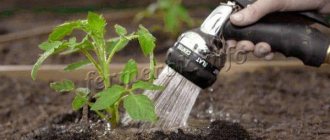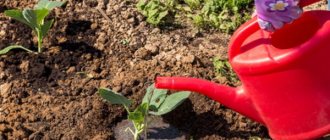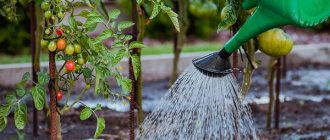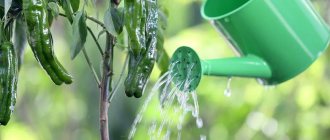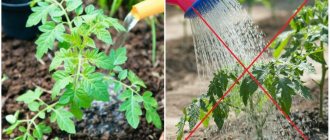General watering rules
Watering zucchini is one of the basic agrotechnical measures. Chronic water deficiency inevitably leads to:
- reduction in the number of fruit ovaries, drying and falling of buds;
- deterioration in fruit quality.
There is no clear scheme for watering zucchini; it is necessary to take into account the climatic characteristics of the region, the nuances of the weather and the place of cultivation. But there are general rules that you can follow:
- Zucchini needs relatively infrequent but abundant watering.
- The soil is soaked 30-40 cm deep.
- Between procedures, the soil is allowed to dry at least 3-4 cm.
- The substrate is moistened when the sun is least active, best in the evening, after sunset. But you can postpone the procedure until early in the morning if it is not hot outside and there is no prolonged drought. Otherwise, the water will simply evaporate without having time to be absorbed into the soil.
- The method is chosen so that drops of water do not fall on the plant. This is especially harmful for zucchini flowers and fruit ovaries.
- The quality of the substrate is taken into account. Clay and loam are more moisture-intensive soils compared to sandy loam and gray soil. The better the soil “retains” water, the less often the plantings are watered.
- If you mulch a bed of zucchini, you can not only increase the intervals between waterings, but also significantly save time on weeding and loosening. The optimal layer thickness is about 5 cm. The bed is covered with mulch soon after transplanting the seedlings or the emergence of seedlings, while the zucchini has not yet grown much.
The quality and volume of the zucchini harvest directly depend on proper watering. Important! A constantly waterlogged substrate for zucchini is worse than short-term drought. Excessively frequent watering negatively affects the immunity of plants and provokes the development of fungal diseases.
Effect of excess moisture
Do not allow water to stagnate near the roots. To drain it during the rainy season, grooves are made. If necessary, build a canopy over the plantings. Failure to comply with these conditions may result in the following consequences:
- decreased plant immunity. Because of this, fungal diseases develop;
- formation of predominantly superficial roots. Excess moisture interferes with the free access of oxygen, so the root hairs die off;
- inhibition of plant growth - although in the first stages of formation a large amount of liquid contributes to intensive development;
- rotting of fruit tips. They can be cut and the cut area burned, but it is better to rip them off;
- reduction in sugar content.
Water requirements
Water for watering zucchini must meet several criteria:
- "Softness". Tap water straight from the tap is absolutely not suitable for irrigation. It contains calcium, fluorine, and chlorine compounds, to which zucchini react very negatively. To soften, tap water is allowed to settle for about a day, waiting for a grayish or whitish flaky sediment to form. Gardeners also practice “freezing out” harmful impurities. Spring, well, filtered, bottled drinking water does not require preliminary “preparation”.
- Temperature 15-20 °C. The critical minimum for watering zucchini is 10 °C. The colder the water, the worse the roots absorb it, and plant development is slower. In addition, they can give a “shock” reaction to such watering, dropping flowers and fruit ovaries en masse. Too hot water promotes the activation of pathogenic microflora, increasing the risk of zucchini becoming infected with fungal and other diseases.
Most often, gardeners store water for irrigation in barrels and other containers, while simultaneously heating it in the sun
. Important! Rainwater is good for watering zucchini. But only if there are no industrial enterprises near the place of its collection.
Tips to help a beginner
- Water for irrigation must be prepared: the liquid from wells and wells must be heated to air temperature, since the roots are not able to absorb excessively cold moisture. Ordinary tap water must be left in an open container for at least 12-24 hours to precipitate harmful metal salts and ventilate dangerous compounds.
- The best time for watering is considered to be early morning (deadline before 10 o'clock), when the sun has not yet gained strength. Watering is allowed in the evening (after 18.00), but not often, since a decrease in temperature at night combined with an abundance of moisture is a favorable environment for the development of pathogenic microflora. If the day turns out to be dry and cloudy, then you can water even at lunchtime.
- Watering must be carried out exactly at the root, avoiding falling on the foliage, since bright sunlight can cause severe burns on delicate greenery and destroy the plant.
- When asking how many times to water zucchini, they are guided by the degree of soil moisture. The soil should remain moist to a depth of 35-40 cm so that there is enough moisture to saturate the extensive root system. The growth phase and weather conditions in the region are also taken into account.
- It is impossible to allow waterlogging or, conversely, drying out of the root zone. More frequent watering will be required for light, loose sandy loam, since the water here quickly evaporates and seeps deeper. For heavy loams, on the contrary, the frequency of irrigation and the volume of water should be reduced to prevent waterlogging of the area.
- Watering can be combined with fertilizing with fertilizers in liquid form, this is especially convenient when using a drip system.
- The next day after moistening (artificial or natural), it is necessary to carefully loosen the soil around the vines and cover with a thin layer of mulch (straw, peat, rotted sawdust, etc.). The thickness of the layer depends on the type of soil: for loose sandy soils - thicker 5-7 cm, for loams - no higher than 4.5 cm.
The crop responds to proper watering with great gratitude, delighting its owners with a bountiful harvest. It is important to focus on the weather and promptly respond to changes that occur in the beds, then the zucchini will develop actively and correctly.
How often should you water zucchini in open ground?
The frequency of watering zucchini and the volume of water consumed depends not only on climatic and weather nuances, their cultivation in open ground or in a greenhouse, and the quality of the substrate. You also need to consider the stage of plant development.
Watering zucchini in open ground during flowering
After the buds form, zucchini require more frequent watering than before. It is necessary to switch to moistening the substrate every 3-4 days. At the same time, the volume of water spent per plant is increased to approximately 8-10 liters.
Proper watering of zucchini at this stage of their development is especially important. For moisture deficiency:
- leaves lose their tone, turn yellow, dry out and die;
- predominantly “male” flowers are formed that do not produce ovaries;
- the resulting fruits grow very slowly and often dry out at an early stage of development.
Important! Even in extreme heat and in the absence of precipitation, it is impossible to switch to daily watering of zucchini at the time of budding and formation of ovaries. With constant waterlogging of the soil, the fruits also fall off, and those that do ripen are characterized by very low shelf life and an almost complete lack of taste.
Proper watering of flowering zucchini is the key to a good harvest.
Watering zucchini in open ground during fruiting
If during fruiting the weather is fairly warm and clear, moderate precipitation is typical, the zucchini is watered every 5-7 days. The water consumption rate is not reduced compared to the flowering phase and the formation of fruit ovaries.
When moistening the beds “by area”, approximately 12-15 l/m² are consumed
Important! To determine whether the time has come for the next watering of zucchini at the fruiting stage, you can focus on the condition of the substrate. If the soil clenched in a fist does not turn into a lump, but crumbles, it’s time.
Watering zucchini in open ground in the heat
In extreme heat and in the absence of natural precipitation, zucchini require watering twice a week. Otherwise, the overall yield and quality of the fruit are greatly reduced. The volume of water consumed depends on the age of the plants. For zucchini recently transplanted into open ground, 2-3 liters is enough. For adult plants, the watering rate is increased to 8-10 liters.
At extremely high temperatures and drought, the substrate is moistened every other day, but this is a fairly rare occurrence.
Important! In hot, clear weather, it is especially important to avoid dripping water on the plant. Under the influence of sunlight, they turn into “lenses”; burns remain on the zucchini after watering.
Watering zucchini in open ground after planting
When planting seeds in open ground, the soil is well moistened. Therefore, there is no need to water the zucchini before the shoots appear. When the seeds germinate, the substrate is constantly kept slightly moist. The approximate interval is 4-5 days, the norm is 1-1.5 liters per plant. But it is better to focus on the condition of the zucchini leaves - if they sag, lose their tone, the plants need regular watering.
The holes for seedlings are also shed with water. It lasts for plants for 5-7 days. Then watering the zucchini after planting in open ground is carried out weekly, starting with 2-3 liters of water per bush and increasing the rate as they grow.
It is very important not to use hot water at this stage of development. Overheating of the root system and its subsequent cooling greatly inhibit the development of zucchini.
Watering is carried out very carefully - the roots of the seedlings have not yet had time to “go into the ground”; if the soil is washed off from them, they will quickly dry out
Important! After planting seedlings or zucchini seeds in open ground, it is advisable to build a canopy of white covering material over the bed to prevent water from evaporating too quickly from the soil after watering.
Consequences of lack of moisture
Lack of water is harmful to the crop, especially during the first half of the growing season. Even short-term drought provokes a decrease in yield.
Lack of moisture negatively affects plantings:
- more male flowers are formed than female ones - in this case, no harvest is expected;
- zucchini are formed small;
- crop growth slows down;
- The taste of the fruits decreases - they begin to taste bitter.
To keep moisture in the ground longer, zucchini is mulched. To do this, you can use humus, matured compost, or rotted straw. The mulch is laid in a layer of 2-3 cm. When used, the bushes will receive additional nutrients.
How often to water zucchini seedlings on the windowsill
Excessively abundant or frequent watering will almost certainly ensure the development of “black leg” and the death of zucchini seedlings even before planting in the ground. Therefore, the intervals between them are determined based on the tone of the leaves and the plants themselves.
It is usually enough to water zucchini seedlings at home once every 4-5 days. Water is poured exclusively under the root or along the “perimeter” of the container so that drops during watering do not fall on the seedlings.
The substrate must be completely wetted so that water begins to come out of the drainage holes.
Features of irrigation in a greenhouse
The most reliable “indicator” in a greenhouse is the condition of the soil. If the soil bakes into a “crust” and begins to crack, you need to water the plants immediately. But, of course, it’s better not to let it get to this point: it is recommended to water the zucchini once a week. In extreme heat, the intervals are reduced to 4-5 days. The norm for one plant is 10-12 liters.
Each watering of zucchini in a greenhouse must be “combined” with loosening the soil and airing
Important! It is not recommended to collect zucchini in a greenhouse immediately after watering. It is advisable that 4-6 days have passed since the last time the soil was moistened.
What is zucchini and what is it eaten with?
The vegetable is a type of pumpkin. But it differs from it in the shape of the fruit, taste and color of the pulp. Zucchini contains few calories, a lot of plant fiber and a lot of useful components. It does not cause allergic reactions. It is not for nothing that the first vegetable purees for children consist of its pulp.
Zucchini
It is also ideal for dietary nutrition. With only 30 kilocalories per 100 grams, it can cause a long-lasting feeling of fullness. The vegetable can be prepared as an independent dish or combined with other products. It goes well with meat and fish. For the winter you can marinate it or make delicious caviar from it.
Only healthy fruits have beneficial properties. To grow them, you need to know how to properly start watering zucchini from the very first days. The quality and quantity of the harvest will depend on this.
Watering methods
The most preferable methods of watering zucchini prevent drops of water from falling on the plant. Also, when choosing a method, gardeners need to take into account their own employment and planting area.
Manual
The classic “old-fashioned” method is to water zucchini from a watering can with a divider or a long “spout.” Best suited for small beds. The watering procedure is quite labor-intensive - you need to carefully lift the leaves and stems of each plant so that the water gets directly under the root.
Manual watering of zucchini takes a lot of time and effort from the gardener.
Hose Irrigation
An improved manual method of watering zucchini, allowing you to quickly “process” a large area. Water is “delivered” to the beds by gravity, due to the difference in height between the location of the container and the plantings, or it is “pumped” by pressure created by mechanisms. The hose must have a splitter nozzle with fairly small holes.
If you do not use a divider, water supplied under strong pressure during irrigation can wash away the soil from the roots and damage the plants themselves.
Drip
One of the best methods not only for zucchini, but also for other crops. Valued by gardeners, including for its economical water consumption.
The essence of the technique is the “targeted” delivery of water “individually” to each plant. A hose with holes is laid along the row of zucchini, to which tubes of smaller diameter are connected. They are brought to each bush, ensuring that water flows directly to the roots when watering.
You can buy a drip irrigation system or assemble it yourself. The last option is the most primitive and “works” exclusively on a flat surface. However, due to the method of water supply, there is a difference in the moisture content of the substrate between the first and last plants in the row - some regularly suffer from waterlogging, others from “thirst”. Store drip irrigation systems ensure uniform water supply when watering zucchini, thanks to the presence of regulating valve-membrane structures.
Drip irrigation systems can be controlled manually or automatically
Sprinkling
Not the best watering method for zucchini. This method is used mainly when growing them on farms over large areas. A special complex is required.
Water from a central water supply or other source, supplied under high pressure, is “dispersed” over the beds, passing through nozzles with very small holes. A “suspension” or “fog” of tiny droplets forms in the air, settling on the plants. Accordingly, this method of watering zucchini in open ground can be practiced only after germination.
The main advantages of sprinkling are economical water consumption and uniformity of watering
Dosed
A fairly effective homemade analogue of drip irrigation for zucchini from plastic bottles. The system allows you to relatively evenly wet the substrate in the garden bed. Next to each bush, a 5 liter plastic bottle with a cut bottom is buried, neck down, to a depth of 12-15 cm, having previously made several holes with a diameter of 2-3 mm in the lid. When it’s time to water the zucchini again, the containers are simply filled with water.
There is an option that involves hanging bottles next to the plants, but their position will have to be changed regularly so that water does not fall on the bush. Another disadvantage of this method of watering zucchini is the gradual erosion of the substrate at the roots by drops of water.
On sale you can find special attachments for bottles dug into the ground for dosed watering.
Wick
A fairly economical and uncomplicated way to water zucchini. In the center of the bed you need to bury a bucket or pan of sufficiently large volume and “stretch” “wicks” made of relatively dense fabric from it to each bush, placing them in grooves 10-15 cm deep and covering them with earth.
To water the zucchini, fill the container with water so that it reaches the end of the wick. The fabric will gradually become wet along its entire length, keeping the soil moderately moist. The main thing is not to forget to “replenish” the water in the bucket or pan.
Wick watering is more often practiced when growing indoor flowers, but it is also in demand in the garden
Caring for zucchini after watering
One of the secrets to a large, healthy zucchini harvest is the use of mulching. Traditional cultivation of soil under leaves is fraught with disruption of the root system, causing injury to leaves and fruits. An effective alternative here is to cover the soil under the leaves with a layer of mulch. A layer of crushed plant residues mixed with straw prevents the sun from drying out the soil, and at the same time retains moisture under the plant. Mulching will reduce the number of waterings, since moisture is retained more efficiently.
Mulching zucchini
While engaged in plant growing, many gardeners gain experience in how to properly and often water zucchini in the open ground, focusing on the condition of the plant foliage, the size of the pilaf, their quantity and the intensity of flowering.
Common Mistakes
Watering zucchini seems like a simple and straightforward procedure. However, an inexperienced gardener can make mistakes, thereby causing harm to the plants:
- Unsuitable temperature. Cold water for watering zucchini is a strong “stress” for plants, causing the flowers and ovaries to fall off, and the fibrous roots to die. Hot temperatures significantly slow down the development of plants.
- Too frequent and/or excessive watering. In a garden bed that has been turned into a “swamp,” the zucchini will almost certainly become infected with rot.
- Drops of water falling on the leaves. If this happens regularly, they turn yellow and sunburn appears.
- Watering zucchini during the day, during maximum solar activity. Water evaporates very quickly, without having time to wet the soil. The soil dries out even with regular moistening in the required amount.
- Neglect of loosening and weeding. They are carried out the next day after watering the zucchini. Otherwise, the soil “bakes” into a hard crust into which water cannot be absorbed. It also interferes with normal air exchange. Weeding is necessary to control weeds, which are serious “competitors” for zucchini in the fight for water and nutrients.
An incorrectly chosen method of watering zucchini will almost certainly lead to rotting of the plants and fruits.
Important! It is highly recommended to mulch beds with zucchini. This procedure protects the soil from overheating, minimizes the likelihood of soil being “washed away” from the roots, and saves time on loosening and weeding.
